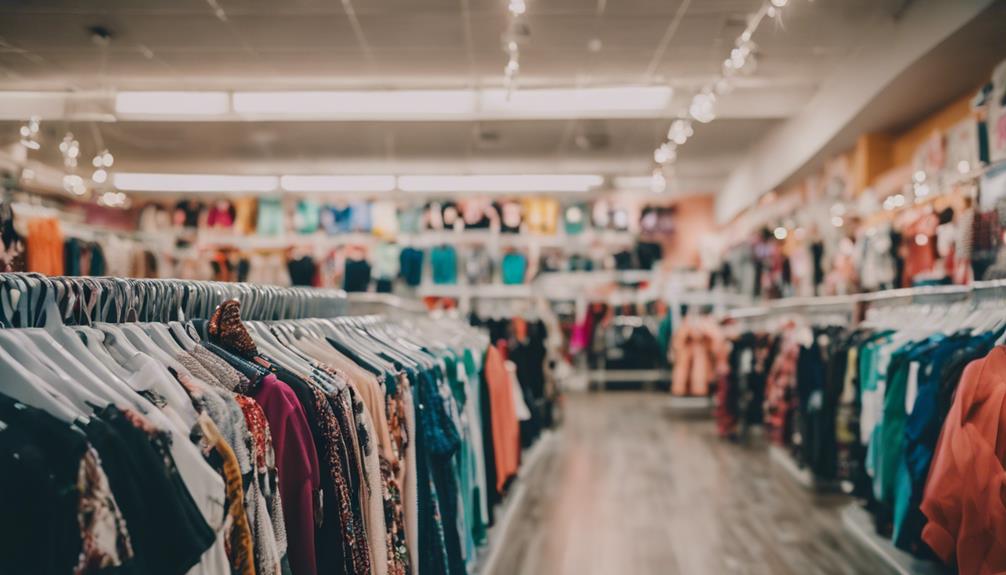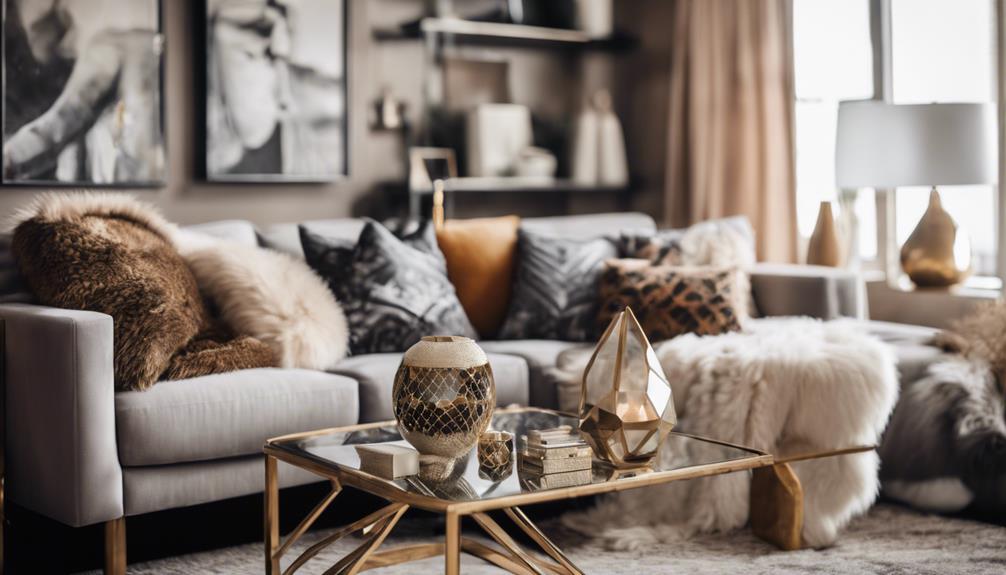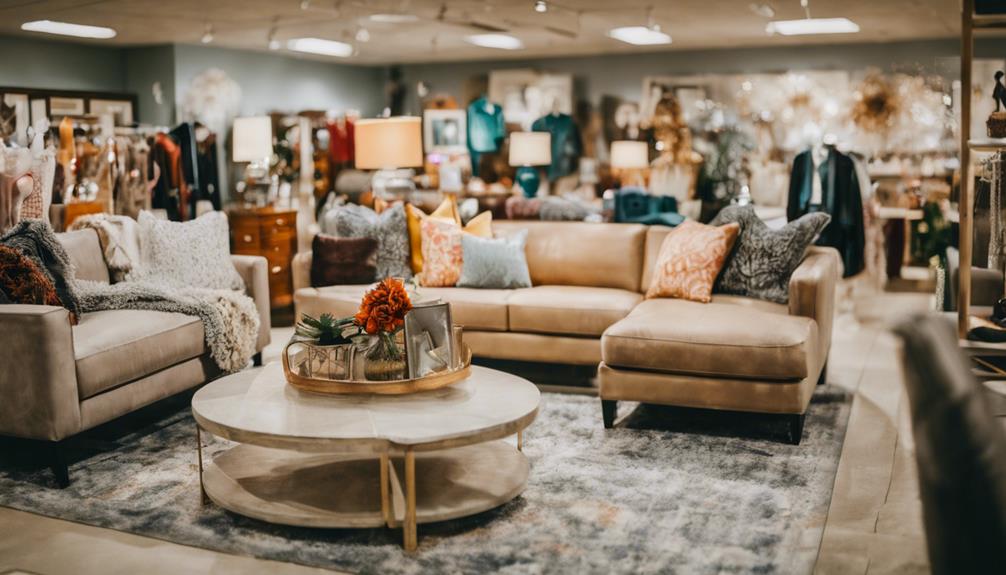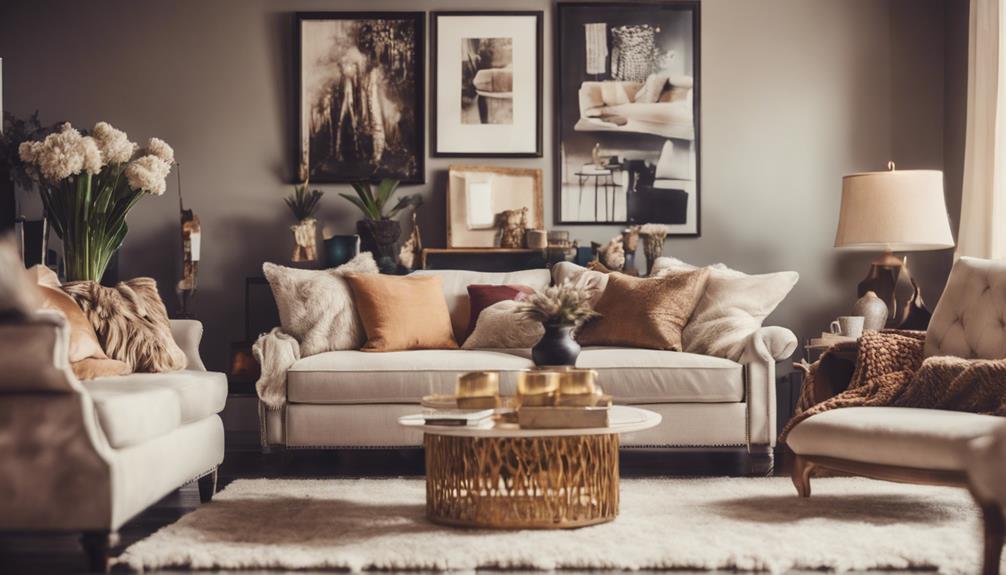Plato’s Closet sometimes accepts stylish home decor items, in addition to their main focus on fashionable clothing. Although the store primarily specializes in apparel, they do offer a small variety of trendy home decor pieces that are in good condition and align with current trends. This presents an opportunity for individuals to exchange unwanted items such as lamps, wall art, and small rugs for cash. If you are interested in learning more about the specific exceptions for home decor items and customer expectations, there are intriguing details available for you to explore.
Key Takeaways
- Plato's Closet occasionally accepts trendy home decor items.
- They offer cash for selected home decor items in good condition.
- The focus is primarily on selling trendy clothing items.
- Limited home decor selection available alongside apparel.
- Emphasizes recycling and reusing pre-owned decor items.
Plato's Closet Focus on Clothing

Plato's Closet primarily focuses on selling trendy and fashionable clothing items for men and women. Specializing in gently used clothing, Plato's Closet offers a wide selection of second-hand items at affordable prices. While the store mainly caters to clothing, it may occasionally accept select home decor items like dorm decor. However, the main emphasis remains on providing customers with stylish and up-to-date apparel options.
Plato's Closet is renowned for offering cash or store credit for gently used clothing items in good condition that meet their buying criteria. This approach allows customers to refresh their wardrobes without breaking the bank. The store's focus on trendy clothing ensures that shoppers can stay fashionable without overspending.
Although home decor isn't the primary focus of Plato's Closet, the occasional availability of select items provides a unique shopping experience for those looking to spruce up their living spaces alongside updating their wardrobe.
Limited Home Decor Selection

While Plato's Closet primarily focuses on selling trendy clothing items, its limited selection of home decor pieces provides customers with the opportunity to enhance their living spaces alongside updating their wardrobe.
In locations like Williston, VT, Plato's Closet buys select home and dorm decor items in addition to clothing, but the emphasis remains on second-hand retail, resulting in a constrained variety of home decor pieces available for purchase. To guarantee the items meet their standards, home decor pieces accepted by Plato's Closet must be in good shape. This means that customers looking to sell gently used home decor items to the store for cash need to make sure that the items are well-maintained.
While the store is primarily known for its clothing selection, this limited offering of home decor items allows customers to clear out unwanted decor pieces while potentially finding new additions to spruce up their living spaces.
Occasional Trendy Decor Acceptance

Occasionally, trendy home decor items such as wall art, small furniture, and decorations are accepted by Plato's Closet. While the store mainly deals in clothing, it does show openness to stylish home decor pieces that meet certain criteria. These decor items should be in good condition and reflect current trends to be considered for sale.
Although home decor isn't the primary focus, Plato's Closet may even offer cash for selected home and dorm decor items that align with their standards. If you're looking to sell home decor to Plato's Closet, it's best to reach out directly to the store or keep an eye on their social media for any updates regarding acceptable items.
Remember that while the acceptance of home decor is occasional, it presents an opportunity for those with trendy pieces to potentially earn some cash by selling them to Plato's Closet.
Home Decor Inventory Needs

Plato's Closet in Williston, VT actively seeks diverse home decor items to cater to varying tastes. Their inventory includes trendy pieces alongside classic options, ensuring a wide selection for customers.
With competitive pricing and occasional discounts, Plato's Closet offers budget-friendly decor solutions for all.
Home Decor Selection
Looking to spruce up your living space with budget-friendly, pre-owned home decor items? Plato's Closet in Williston, VT might've just what you need. While primarily known for fashion, this store also buys select home and dorm decor items.
They focus on second-hand retail, providing affordable options for home decor enthusiasts. If you have gently used home decor items in good condition, you can even sell them to Plato's Closet for cash.
Trendy Items in Stock
If you're seeking trendy items at Plato's Closet in Williston, VT, you'll find a diverse selection of fashionable clothing and accessories for men and women, including tops, bottoms, dresses, shoes, and more.
Home decor items aren't typically part of Plato's Closet's inventory. The store focuses on buying and selling trendy clothing pieces rather than home decor. Customers looking to sell home decor items may need to explore alternative stores or platforms specializing in home goods resale.
Plato's Closet caters to college students and young adults looking for affordable and stylish clothing options. The inventory at Plato's Closet is geared towards meeting the fashion needs of its target demographic, offering a range of trendy and in-demand clothing brands for both men and women.
Pricing and Discounts
When shopping at Plato's Closet in Williston, VT, you'll discover that the focus on pricing and discounts is geared towards their selection of trendy clothing items rather than home decor inventory needs.
The store specializes in buying and selling gently used clothing for college students and young adults, offering generally lower prices than traditional retail stores. Discounts may be available during clearance sales or promotional events, attracting budget-conscious shoppers looking for affordable and fashionable options.
However, home decor items aren't a priority for Plato's Closet, which primarily focuses on second-hand apparel.
Better Stores for Home Decor

When searching for quality home decor items, consider exploring stores like HomeGoods, Target, IKEA, or local thrift shops for a wide range of options and deals. These stores offer a diverse selection of home decor items including furniture, bedding, kitchenware, and decorative pieces.
Here are some reasons why these stores are great options for your home decor needs:
- HomeGoods: Known for its ever-changing inventory of unique and trendy home decor items at discounted prices.
- Target: Offers a variety of stylish and affordable home decor collections, from modern to traditional designs.
- IKEA: Provides a wide selection of functional and stylish furniture and home accessories at budget-friendly prices.
- Local Thrift Shops: Treasure troves for one-of-a-kind vintage pieces and affordable home decor finds.
- Seasonal Sales and Promotions: Many home decor stores offer sales, clearance events, and loyalty programs to help you save money on your purchases.
Exploring these stores and keeping an eye out for deals can help you find the best decor pieces to enhance your living space without breaking the bank.
Plato's Closet and Home Goods

Plato's Closet in Williston, VT offers a selection of home decor items alongside their clothing inventory. The store focuses on providing affordable second-hand options for customers, including those looking to buy home decor items.
If you're in the market for budget-friendly home goods, Plato's Closet might be worth exploring for both trendy and sustainable options.
Home Decor Availability
Looking for affordable home decor options? Plato's Closet in Williston, VT offers a selection of second-hand home and dorm decor items in good condition. Here's what you need to know about their home decor availability:
- The store buys select home decor pieces and pays cash for accepted items.
- You can sell gently used home decor to Plato's Closet and declutter your space.
- Plato's Closet encourages sustainability by reusing pre-owned decor items.
- While their main focus is clothing, they do accept and sell a variety of home decor items.
- Check out Plato's Closet for budget-friendly decor options that are both stylish and eco-friendly!
Pricing for Decor
For budget-conscious shoppers, comparing pricing for decor between Plato's Closet and traditional home goods stores can reveal significant savings. Plato's Closet, known for its second-hand retail focus, offers gently used decor items at lower prices than many home goods stores. This difference in pricing allows customers to find affordable decor options without breaking the bank.
By selling unwanted decor to Plato's Closet, individuals can also earn cash while decluttering their living space. The store's emphasis on recycling and reusing pre-owned items not only benefits customers financially but also promotes sustainability by giving new life to home decor pieces.
Specific Home Decor Exceptions

When considering home decor items to sell at Plato's Closet in Williston, VT, keep in mind the store buys select pieces beyond just clothing. While Plato's Closet mainly focuses on second-hand clothing, they do make exceptions for certain home and dorm decor items.
Here are some specific home decor exceptions you can sell at Plato's Closet:
- Throw pillows in good condition
- Wall art and posters
- Small rugs or doormats
- Lamps and lighting fixtures
- Decorative storage solutions like baskets or bins
These items should be gently used and in good shape to be considered for selling at Plato's Closet. If you have any of these home decor pieces lying around and you're looking to clear out some space, Plato's Closet in Williston, VT offers you the opportunity to turn them into cash.
Customer Expectations for Home Decor

What specifically do customers expect when it comes to home decor at Plato's Closet in Williston, VT?
Customers visiting Plato's Closet in Williston, VT, can expect to find a selection of gently used home and dorm decor items available for purchase. The store prides itself on offering affordable prices for second-hand retail items, including home decor pieces.
When selling home decor to Plato's Closet, customers should make sure that the items are in good shape to meet the store's acceptance criteria.
As part of its commitment to sustainability, Plato's Closet promotes the recycling and reusing of pre-owned decor items, aligning with the eco-conscious values of many customers.
Therefore, customers looking to buy or sell home decor at Plato's Closet can anticipate finding a range of affordable and well-maintained items while contributing to environmentally friendly practices.
Final Thoughts on Home Decor at Plato's Closet

In wrapping up the discussion on home decor at Plato's Closet, consider the diverse range of affordable and sustainable options available for customers seeking to refresh their living spaces.
- Plato's Closet in Williston, VT buys select home and dorm decor items.
- The store focuses on second-hand retail, offering affordable second-hand items.
- Customers can sell gently used home decor to clear out unwanted items.
- The store promotes sustainability by recycling and reusing pre-owned goods.
- While primarily known for clothing, Plato's Closet also buys and sells select home decor items.
Plato's Closet provides a unique opportunity to find budget-friendly home decor pieces while supporting sustainable practices. By recycling and reusing pre-owned goods, you not only save money but also contribute to reducing waste. So, next time you're looking to spruce up your living space, don't forget to check out Plato's Closet for some hidden gems that could give your home a fresh new look.
Frequently Asked Questions
What Does Platos Closet Not Take?
Plato's Closet doesn't accept home decor items for resale. The store focuses on clothing and accessories, excluding items like furniture, wall art, and bedding.
If you're looking to sell home decor, explore other resale stores in your area. Plato's Closet's buying criteria specifically excludes home decor, so check their accepted items list before selling.
Stick to gently used clothes and accessories when selling at Plato's Closet.
What Brands Does Platos Closet Accept?
Plato's Closet accepts popular clothing brands such as Abercrombie & Fitch, American Eagle, Lululemon, BDG, and Nike. Bringing in items from these sought-after brands can increase your chances of selling to Plato's Closet and might lead to higher payouts.
Ensuring your gently used items are from these accepted brands can make the selling process smoother. Remember, the more trendy and in-demand the brand, the better your chances of selling at Plato's Closet.
What Does Plato Closet Sell?
Plato's Closet sells second-hand clothing and accessories primarily. They focus on gently used items like tops, bottoms, dresses, shoes, and accessories from popular brands.
While not specializing in home decor, some locations may buy select decor items if they're in good condition. For those wanting to sell home decor, it's best to check with your local store for specific guidelines.
Call or visit their website for more details on accepted items and the selling process.
What's the Most Platos Closet Pays?
The most Plato's Closet pays for your items can be up to 30-40% of the resale price. To get the best value, focus on bringing in high-quality, stylish pieces from popular brands.
When you sell to Plato's Closet, you can choose between getting cash or store credit. Remember, the better the condition and demand for your items, the higher the payout. So, think quality over quantity to maximize your earnings!
Conclusion
To sum up, while Plato's Closet primarily focuses on selling clothing, they do offer a limited selection of home decor items. However, their inventory may not always cater to all customer preferences.
For a wider variety of home decor options, it may be advisable to explore other stores specializing in such items.
Think of Plato's Closet as a wardrobe full of stylish outfits, with a few scattered accessories for your living space.









